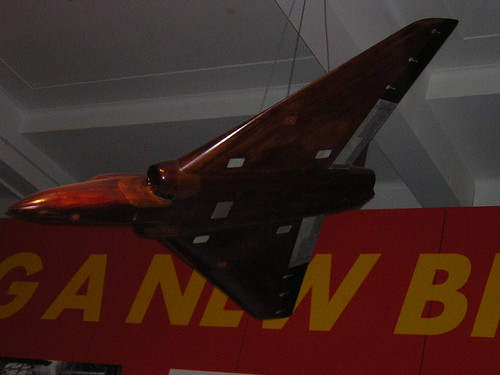
Science Museum: Wind Tunnel Models
In the days prior to Computational Fluid Dynamics (CFD), wind tunnel testing was the primary method for assessing the performance of airplanes prior to actually building them. On my visit to the London Science Museum I noticed a number of wind tunnel models of historic significance that I'll share with you here.
Concorde
The museum has a unique collection of wind tunnel models used to investigate different delta wing and fuselage configurations for Concorde. Concorde was the world's premier supersonic passenger airplane until it was retired from service in 2003. Designed and manufactured by Aerospatiale (France) and British Aircraft Corporation, it first flew in 1969 and could sustain Mach 2.04 in flight.
In order to verify the design, wind tunnel testing would have taken up significant resources both in terms of time and money. High speed wind tunnel testing is extremely expensive, slow (intermittent tests) and potentially dangerous given the high pressure storage tanks needed. If CFD had been available during Concorde's design it would have significantly reduced costs.
Avro Vulcan
Suspended from the museum ceiling is an Avro Vulcan low-speed wind-tunnel model of the entire airplane made of wood. Many carpenters were gainfully employed as model makers in the early days of the jet age building exquisitely detailed wind tunnel models.
The design of the Vulcan commenced in 1947 under the leadership of the legendary airplane designer Roy Chadwick. Prior to producing the Vulcan prototype, 4 one-third scaled prototypes (Avro 707) were built and flown to gather data on the delta wing configuration. Here's another example of an extremely expensive approach to proving a design - building and flying prototypes - and again CFD now provides a cost-effective means to avoid such expenses except in exceptional circumstances.
The Rolls Royce Olympus engines designed for the Vulcan were also used, in modified form, on Concorde.
Avro 730 Supersonic Bomber
Although I don't have a picture (the Science Museum does though), the final wind tunnel model I'd like to draw your attention to is a high-speed wind-tunnel model (metal construction) of the Avro 730 supersonic bomber. Although it never made it out of the wind tunnel (off the drawing board) the Avro 730 was an ambitious project to build a Mach 3 reconnaissance and nuclear bomber, similar in concept to the SR71 (Blackbird).
In a sweeping policy change in 1957, the British government decided that rockets would be more effective in delivering nuclear ordinance, so the Avro 730 was deemed obsolete before it even flew. However, prior to canceling the project, work had started on a high-speed technology demonstrator, the Bristol 188, which was allowed to continue. Data gathered from flying the Bristol 188 and the engines it used fed into the design of Concorde.
Recent blog posts
- CFD Simulates Distant Past
- Background on the Caedium v6.0 Release
- Long-Necked Dinosaurs Succumb To CFD
- CFD Provides Insight Into Mystery Fossils
- Wind Turbine Design According to Insects
- Runners Discover Drafting
- Wind Tunnel and CFD Reveal Best Cycling Tuck
- Active Aerodynamics on the Lamborghini Huracán Performante
- Fluidic Logic
- Stonehenge Vortex Revealed as April Fools' Day Distortion Field


